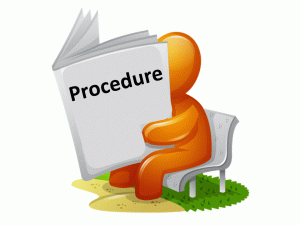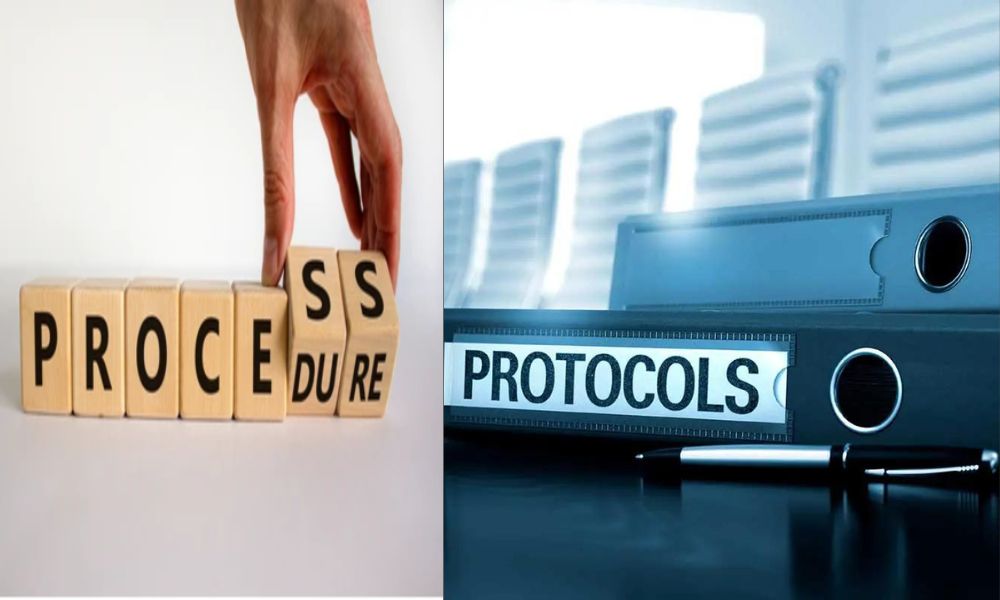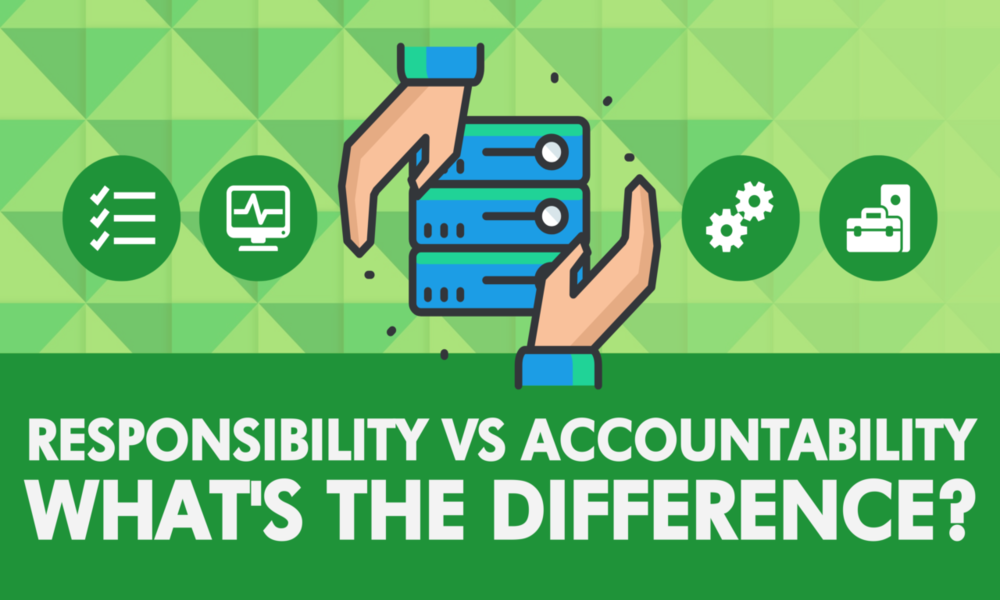Introduction
Protocol and procedure are terms commonly used across many fields and industries, yet their distinction must be clearly understood in order to effectively apply them.Both protocols and procedures provide guidelines for carrying out tasks or processes; however they vary greatly in terms of nature, scope, and application.By understanding their unique characteristics and purposes, individuals and organizations can more efficiently navigate their respective domains, ensure clear communications, streamline operations, and ultimately enhance overall performance.
Following are several sections that will explore the definitions, distinguishing features, examples and roles of protocol and procedure in various fields; their dissimilarities; as well as emphasize their significance to gaining a comprehensive understanding.By the time this discussion is concluded, readers will have gained an in-depth knowledge of both concepts enabling them to apply them appropriately within their environments.
Definition of protocol
Protocol is a set of rules, guidelines, or conventions which specifies how a particular process, communication, or interaction should take place. Standards provide a standard framework to promote consistency, efficiency and interoperability across various fields including technology, science, healthcare and more.
Protocols often define specific steps, procedures or formats that must be followed in order to reach an intended outcome or promote effective communication between multiple systems, devices or individuals.Protocals facilitate communication among complex systems or environments and serve as the foundation of coordination and cooperation among its constituents.From basic HTTP for web browsing to complex networking protocols such as TCP/IP for data transmission over the internet, protocols serve as important means of coordination.

Protocols focus on guidelines for communication or data transfer
Protocols provide guidelines for data transmission or transfer. Protocols outline standardized rules, formats and procedures governing how information flows among systems, devices or individuals – creating an ideal framework for seamless and efficient communications, guaranteeing data is transmitted correctly and consistently.Protocols cover various aspects of communication or data transfer, including addressing, routing, formatting, error handling and security.
Protocols such as Internet Protocol (IP), which specifies how data Packets are routed over the Internet, and Hypertext Transfer Protocol (HTTP), which governs web browser and server Communication when retrieving web pages, ensure Standardized, reliable, and Interoperable communication across systems and Platforms.Companies can achieve efficient and effective communication by adhering to protocols, which allows seamless data transfer and interoperability among various entities.
Protocols are generally highly standardized and widely accepted
Yes! Protocols are widely recognized within their fields. Here’s why:
Standardization: Protocols are intended to establish a universally applicable set of rules and guidelines for specific processes or communications.Their development processes often involve industry experts, standardization bodies, and regulatory authorities – this ensures they remain well-defined, consistent, and broadly applicable across different systems, devices, or organizations.
Widely Accepted: With their standardization, protocols have become widely recognized within their fields of operation, recognized and adopted by industry stakeholders, professionals, and organizations as de facto or official guidelines for accomplishing certain tasks or communicating. This wide acceptance facilitates interoperability and compatibility among various entities and systems.
Collaboration and Compatibility: Protocols provide seamless collaboration and compatibility across diverse systems or networks, enabling effective communication, data exchange, and interaction without complications or conflicts arising between entities implementing similar protocols.This facilitates interoperability, facilitates cooperation, and supports the smooth functioning of complex systems.
Global Reach: Many networking, communication and internet technologies have global reach. Their implementation occurs worldwide to allow consistent data exchange over vast geographical distances while creating greater interconnection and cooperation across regions and industries.
Standardization and widespread acceptance of protocols ensure that organizations can rely on established guidelines and practices for interoperability, compatibility and reliable communication across diverse systems and entities.
Protocols are often applicable in specific fields such as networking, healthcare, or research
Protocols can be seen to be useful in fields like networking, healthcare and research – here’s why they’re often associated with these areas:
Networking: Networking protocols such as the Internet Protocol (IP) and Transmission Control Protocol (TCP), outline rules and procedures for data transmission over computer networks.They ensure that information is appropriately addressed, routed, and delivered between devices on the network as well as across it – playing an invaluable role in creating connections and facilitating seamless communication across systems and networks.
Healthcare: Protocols in healthcare are indispensable in standardizing and streamlining medical procedures, patient care and treatment protocols.Medical professionals use specific protocols when administering medication, performing surgeries, managing emergencies or diagnosing diseases – these ensure consistent evidence-based practices, increase patient safety and ensure efficient healthcare delivery.
Research Protocols: Research protocols provide the standardized methods, procedures, and ethical considerations required to conduct scientific experiments or studies.They outline steps such as data collection, experimental design, analysis, reporting, rigor/replicability/adherence with ethical guidelines while maintaining consistency, valid results, transparency of scientific research etc.
Protocols have become an indispensable element of networking, healthcare and research – however they’re also useful in fields like aviation, telecommunications manufacturing and finance, serving to ensure standard practices within these domains.
Definition of procedure
Procedures are structured sets of steps or actions designed to complete a given task or reach a desired result in order to complete any process, such as fulfilling orders from management.A procedure provides clear instructions and guidelines on how to complete tasks or manage situations in an organized and systematic way – typically to ensure consistency, efficiency, safety, and compliance within an organization or industry.
Procedures vary in terms of their level of detail and formality depending on the complexity and criticality of any task or process, often outlining resources, tools, personnel and timeframes needed for each step in an operation or process.
They may include checklists, flowcharts or diagrams as a means to guide individuals accurately performing their duties with consistent performance across an organization such as healthcare, manufacturing aviation or customer service industries.
Procedures play an integral part in standardizing operations while promoting best practices, mitigating risks ensuring regulatory compliance and maintaining quality control across industries like healthcare manufacturing aviation or customer service among many more – essential roles indeed!

Procedures focus on step-by-step instructions for tasks or processes
Absolutely! Procedures focus on providing step-by-step instructions for tasks or processes, so they should include detailed instructions.
Here’s why procedures center around detailed instructions:
Task Execution: Procedures serve as an invaluable roadmap for individuals or teams executing specific tasks or processes. They break complex tasks down into manageable steps that provide clear instructions on what needs to be done when and how. Procedures also ensure tasks are carried out regularly and accurately, thus reducing errors and increasing productivity.
Consistency and Reproducibility: By offering step-by-step instructions, procedures help foster consistency and reproducibility when it comes to task execution.When individuals follow these same instructions, outcomes remain consistent regardless of who performs it – which is particularly critical in fields that rely on standardization and quality control, such as manufacturing or service industries.
Training and Onboarding: Procedures play an essential role in training new employees or onboarding team members. They offer a standardized method for teaching individuals how to complete specific tasks or processes, making the learning curve smoother for newcomers while shortening transition times in roles and decreasing time-to-competency requirements.
Quality Assurance and Compliance: Procedures play a pivotal role in assuring quality assurance and compliance with industry standards or regulatory requirements. By documenting standard procedures, organizations can establish consistent practices that adhere to quality standards, safety regulations or legal obligations.
Procedures come in many shapes and forms, such as checklists, flowcharts, standard operating procedures (SOPs), manuals or checklists. Each document outlines specific actions, tools, resources, and precautions required at each step in a task or process.
Organizations can ensure tasks are carried out consistently and efficiently by adhering to procedures. Procedures provide clear instructions that help individuals execute their duties accurately while adhering to best practices and quality standards.
Procedures can have varying levels of standardization based on organizational requirements
Absolutely! Procedures can have various levels of standardization based on organizational needs and requirements. Here’s why:
Organizational Context: Organizations operate in diverse environments with differing needs, structures, and priorities; thus the level of standardization required may differ based on these variables. Some organizations may implement strict standardized procedures to maintain consistency and efficiency while others allow more flexible methods that adapt to circumstances or individual preferences.
The complexity of Tasks: The complexity of tasks or processes being conducted can have a dramatic effect on their level of standardization in procedures. More complicated processes may need to follow detailed, standardized steps in order to guarantee accuracy and minimize mistakes; less complex ones may permit greater flexibility and discretion during execution allowing employees to adapt procedures according to individual needs or situations.
Organizations operating within regulated industries, such as healthcare, finance or aviation, typically must abide by stringent compliance requirements to remain compliant. Procedures within these fields must adhere closely to regulating guidelines so as to maintain consistency with legal and industry standards and meet legal compliance.
Flexibility and Innovation: Certain organizations encourage creativity and foster an environment of continuous improvement by allowing employees to experiment, adapt or enhance existing methods. In these instances, procedures may become less stringent to allow room for employees to experiment or adjust existing procedures as necessary – something which fosters creativity, adaptability, and a culture of continuous improvement.
Organizational Culture and Practices: Organizational culture and practices have an enormous impact on the level of standardization in procedures. Some organizations place great emphasis on standardization, consistency, and adherence to established processes; in contrast, others may prioritize flexibility, autonomy, or individual decision-making, leading to less standardized procedures.
Organizations must strike a balance between standardization and flexibility when setting procedures. While standardization helps maintain consistency, quality, and compliance, flexibility allows for adaptation, innovation, and agility. The level of standardization in procedures must correspond with organizational objectives, industry requirements, task characteristics, and task performance requirements.
Procedures may incorporate protocols as guidelines for certain aspects of the process
Procedures may incorporate protocols as guidelines for specific aspects of the process.
Here is how protocols may be integrated into procedures:
Communication Protocols: Procedures that involve communication or data transfer may implement specific communication protocols as guidelines. For instance, when exchanging files between systems using FTP or SMTP protocols to transmit files between systems may include using specific protocols as a set of guidelines to ensure efficient and secure communications between these platforms.
Security Protocols: Procedures that involve handling sensitive information or ensuring data security may include security protocols. These protocols outline steps and guidelines for implementing various forms of data protection measures, such as encryption protocols, authentication methods or access control mechanisms.By including such measures into procedures, organizations can ensure data is safeguarded as per security standards while meeting customer expectations for protecting sensitive data.
Compliance Protocols: Procedures related to regulatory compliance may include specific protocols or guidelines designed to ensure adherence with legal and regulatory frameworks, for instance handling customer data may include protocols related to data protection regulations such as General Data Protection Regulation (GDPR).
Interoperability Protocols: Procedures that involve interoperability among different systems or devices may include interoperability protocols to define standards and ensure seamless integration and communication among disparate systems.By including interoperability protocols in procedures, organizations can ensure compatibility and smooth operations when dealing with external systems or devices.
Integrating protocols into procedures provides specific guidelines and standards for key aspects of the process, helping ensure they align with industry best practices, comply with regulations, and facilitate secure communication or data transfer.By combining protocols and procedures together organizations can develop comprehensive guidelines covering both overall process as well as specific protocols related to that process.
Comparison Table of Protocol and Procedure
Below is a comparison table highlighting the key differences between protocol and procedure:
| Aspect | Protocol | Procedure |
|---|---|---|
| Definition | Set of rules or guidelines for a specific process or communication | Documented sequential steps or actions for accomplishing a task or process |
| Nature | Standardized and widely accepted | Can vary in standardization based on organizational requirements |
| Scope | Focuses on guidelines for communication or data transfer | Focuses on step-by-step instructions for tasks or processes |
| Applicability | Often specific to certain fields (e.g., networking, healthcare, research) | Applicable across various industries and organizational settings |
| Interdependence | Can be a part of a procedure, defining specific steps or actions within it | May incorporate protocols as guidelines for certain aspects of the process |
| Examples | Internet Protocol (IP), Hypertext Transfer Protocol (HTTP), Transmission Control Protocol (TCP) | Employee onboarding procedure, emergency response procedure, manufacturing process procedure |
| Purpose | Ensure consistency, efficiency, and interoperability | Standardize operations, promote best practices, mitigate risks, ensure compliance |
| Level of Detail | May have specific technical specifications and formats | Can include checklists, flowcharts, diagrams, or written instructions |
| Role | Facilitates communication and coordination between systems, devices, or individuals | Guides individuals in performing tasks accurately and consistently |
| Field | Technology, science, healthcare, research | Business, management, healthcare, legal compliance |
| Importance | Clarity in communication, operational efficiency, adherence to standards | Efficiency, consistency, compliance, training, knowledge transfer |
By understanding these differences, individuals and organizations can effectively utilize protocols and procedures in their respective domains, ensuring clarity, efficiency, and adherence to standards.
Clarity and effective communication
One key objective of distinguishing between protocol and procedure is promoting effective communication within an organization or among various stakeholders. Let’s investigate further into this point:
Protocol: for Transparency: When following a specific protocol, all parties involved can have a clear understanding of how information should be exchanged or processes conducted.
Effective Communication: Protocols facilitate seamless communications among various systems, devices and individuals. They ensure messages or data are transmitted in an integrated fashion that enables collaboration and interoperability between these parties.Procedures provide step-by-step instructions for tasks or processes, outlining all actions to take so individuals have a clear understanding of what needs to be done and how.
Effective Communication: Procedures facilitate effective communication by creating a standardized framework for carrying out tasks. They establish a common language and set expectations, which enables individuals or teams to work cohesively towards reaching shared goals. Clear procedures also reduce confusion, cut errors down to size, and boost overall efficiency.
By clearly distinguishing between protocols and procedures, organizations can improve communication clarity. Each concept serves a specific purpose and offers guidance in various areas; this ensures efficient, clear communications among all parties involved.
Operational efficiency and consistency
Traversing the distinctions between protocol and procedure is essential to increasing operational efficiency and maintaining consistency within an organization. Here’s how:
Protocol:
Operational Efficiency: Protocols play an essential part in operational efficiency by setting standard guidelines that all parties involved adhere to, which facilitates smooth communication or data transfer and eliminates the need for ad hoc decision making or troubleshooting, streamlining processes and saving time.
Consistency: Protocols serve as a consistent framework for communication or interaction, ensuring that certain actions or behaviors are followed across various scenarios or participants. This ensures reliability, reduces errors, and allows seamless integration between systems or individuals.
Procedures:
Operational Efficiency: Procedures are intended to maximize operational efficiency by offering structured and documented steps for carrying out tasks or processes. By adhering to such steps, organizations can reduce redundancies, streamline operations and boost productivity and resource utilization resulting in enhanced productivity and resource use.
Consistency: Procedures provide a uniform method for accomplishing tasks, by offering clear guidelines and instructions that ensure all individuals or teams follow identical steps when carrying out their
Responsibilities. This consistency aids quality control efforts by reducing variations in outcomes while creating an atmosphere of reliability and professionalism among team members.Organizations can maximize operational efficiency and achieve greater consistency by differentiating between protocols and procedures, in order to optimize operational efficiency and achieve greater consistency in day-to-day operations.
By clearly outlining guidelines and standard processes, businesses can reduce confusion while improving resource allocation as well as overall performance and outcomes.
Compliance and adherence to standards
Differentiating between protocol and procedure is key for ensuring compliance and adherance to standards within an organization or industry. Let’s further examine this aspect:
Protocol Compliance:
Compliance:
Protocols often serve as industry or regulatory standards, so organizations that abide by them ensure they meet any specific guidelines or regulations relevant to their field. Adherence also helps mitigate risks, ensure data security and uphold ethical practices.
Adherence to Standards:
Protocols are intended to establish widely accepted practices and protocols that organizations adhere to as part of demonstrating their dedication to providing consistent and reliable processes in line with industry or community standards.When an organization adheres to such protocols, they demonstrate their dedication to consistent processes that conform with these industry or community norms.
Procedures:
Incorporating Compliance Standards Into ProceduresProcedures can help organizations meet compliance standards while mitigating legal or reputational risks by outlining necessary steps that ensure tasks and processes are carried out as per legal, ethical and regulatory obligations.Adherence to procedures helps organizations meet these standards without incurring legal risks or reputational risks.
Adherence to Standards:
Procedures provide a framework for adhering to organizational standards and best practices. They outline recommended processes and actions which meet industry norms and quality standards, thus assuring consistency, quality control, and adherence with set standards.
Following established procedures is key in maintaining quality assurance as well as adherence with them.By distinguishing between protocol and procedure, organizations can ensure compliance with regulations, industry standards, and internal policies.
By outlining necessary steps and guidelines for compliance, clear protocols and procedures help organizations reduce noncompliance risk while cultivating an environment of compliance to established standards – helping avoid penalties while building positive stakeholder relations.
Training and knowledge transfer
Differentiating between protocol and procedure is vital to effective training and knowledge transfer within an organization. Let’s investigate how this distinction impacts these aspects:
Protocol Training:
Training protocols provide clear rules and processes for communication or data transfer, making them invaluable in employee training programs. By teaching employees on specific protocols, employees will gain an understanding of standardized practices and procedures related to exchange.This enables them to apply them more effectively within their roles and ensures consistency throughout an organization.
Knowledge Transfer: Protocols provide an efficient knowledge transfer method by setting out standard guidelines. New employees can quickly learn and comprehend these rules, helping them integrate themselves quickly into an organization’s communication or data transfer processes.Furthermore, protocols enable knowledge sharing between team members by serving as a common reference point for communication practices.
Procedure:
Training: Procedures play an essential part in training programs as they offer step-by-step instructions for tasks or processes. Educating employees on procedures ensures they can carry out specific tasks accurately and consistently while developing necessary skillset to fulfill their responsibilities effectively.
Knowledge Transfer: Procedures act as a repository of organizational knowledge. Documented procedures serve as an easy reference guide for employees, ensuring knowledge related to processes and tasks is consistently transferred across employees.Procedures can also be shared, updated and improved upon so as to retain valuable know-how within your organization.
Organizations can leverage this distinction between protocol and procedure to design tailored training programs that cover both standard guidelines for communication (protocols) and step-by-step instructions for tasks (procedures).This facilitates knowledge transfer efficiently while equipping employees with necessary skillsets ensuring consistency and proficiency when performing tasks while adhering to established protocols.
Conclusion
Knowledge of protocols and procedures is key for effective organizational management and operations. Protocols focus on communicating or transmitting data while procedures provide step-by-step instructions for tasks or processes.
Here is a brief recap:Protocols create standard guidelines for communication or data transfer, ensuring consistency, interoperability and compliance with industry or regulatory standards.Procedures provide detailed instructions for performing tasks or processes, with the aim of increasing consistency, efficiency and adherence to best practices.
Protocols are widely accepted within specific fields, such as networking, healthcare or research; this enables more effective communication and data exchange.







